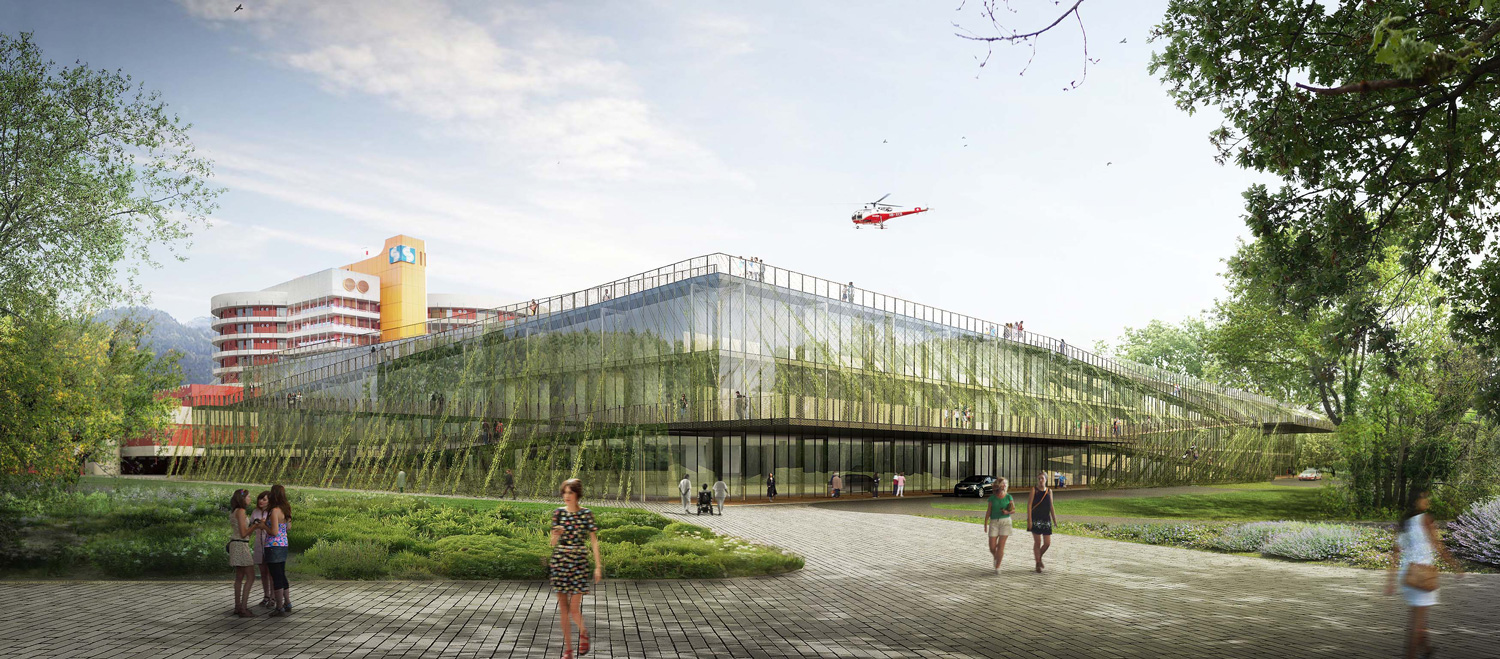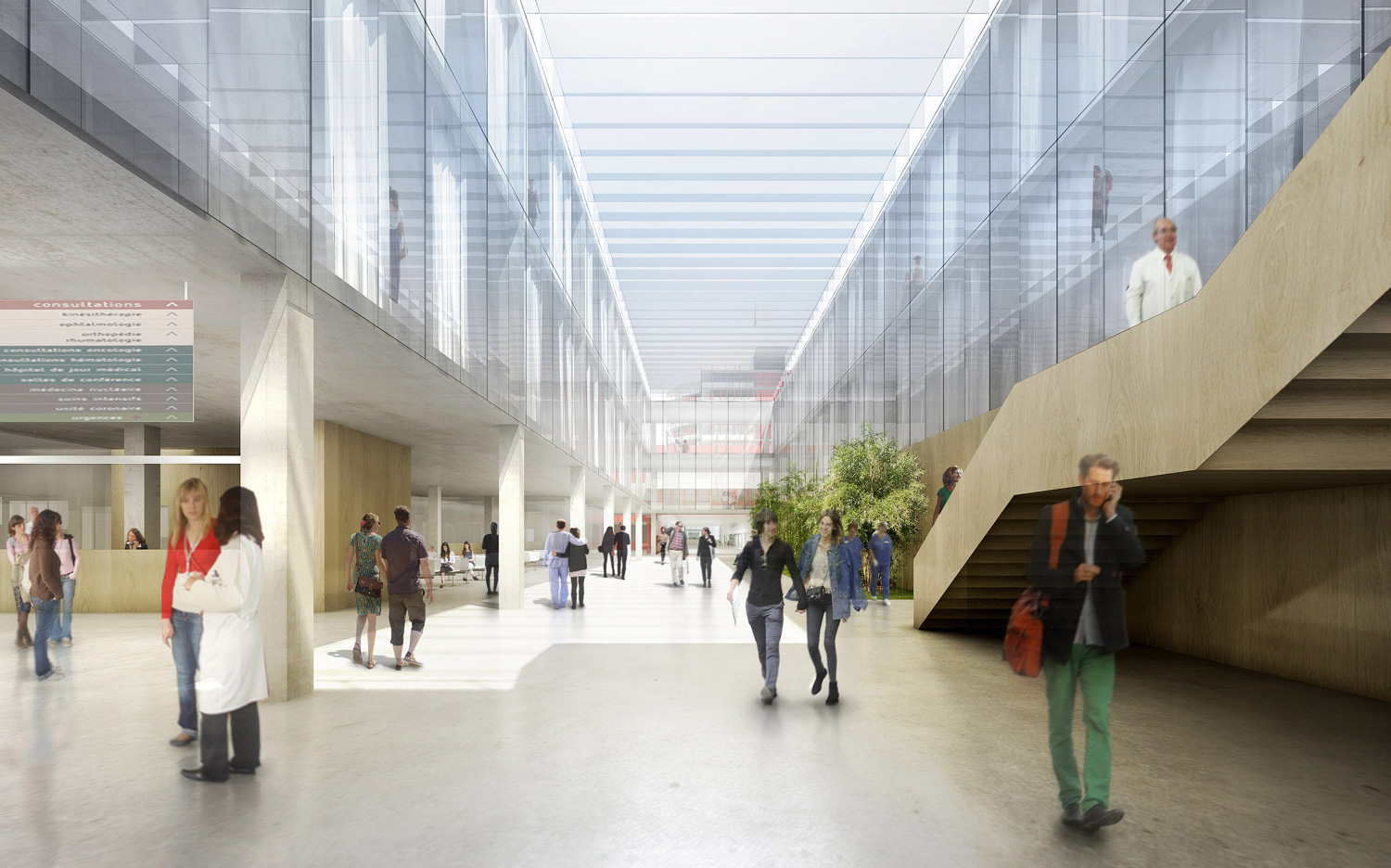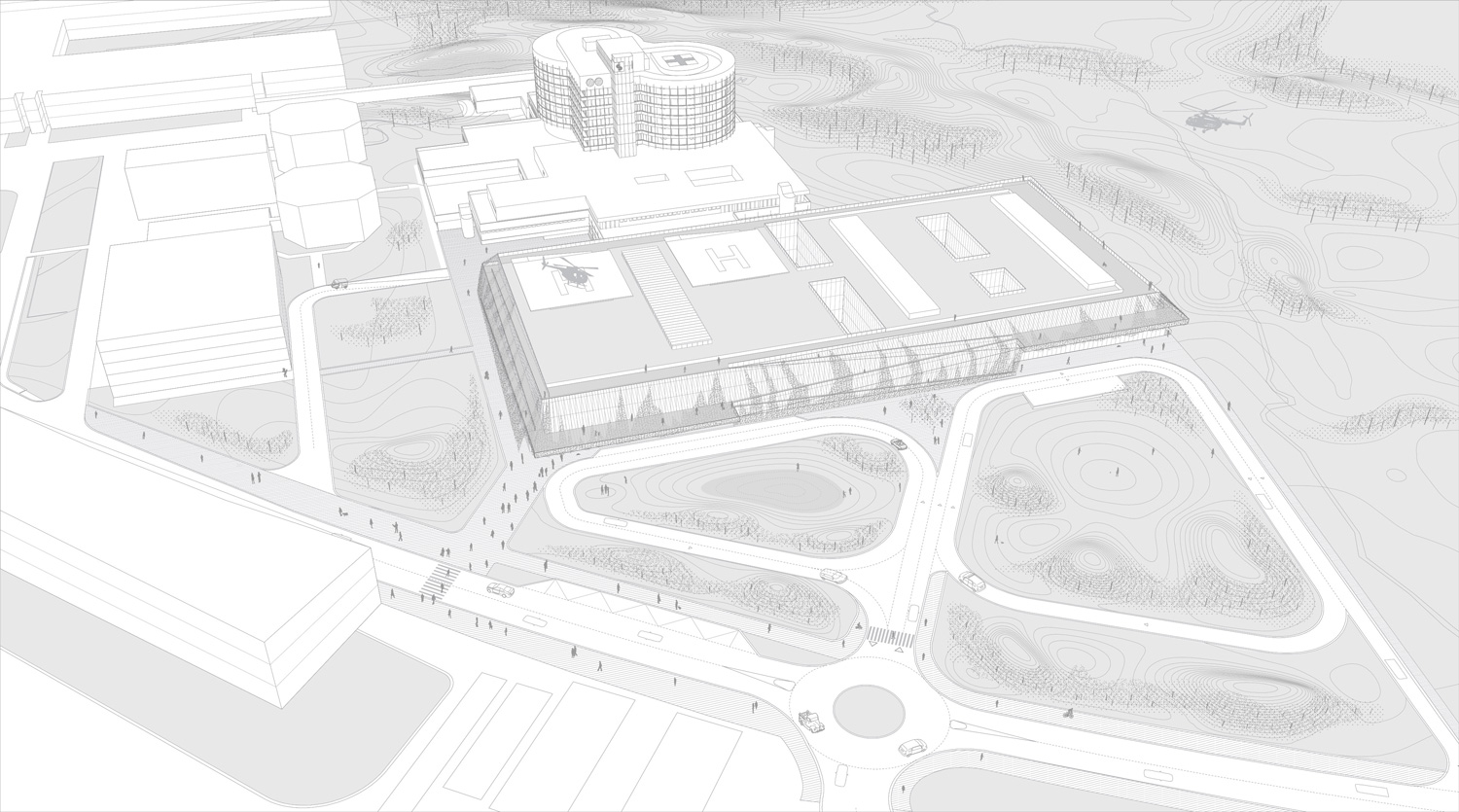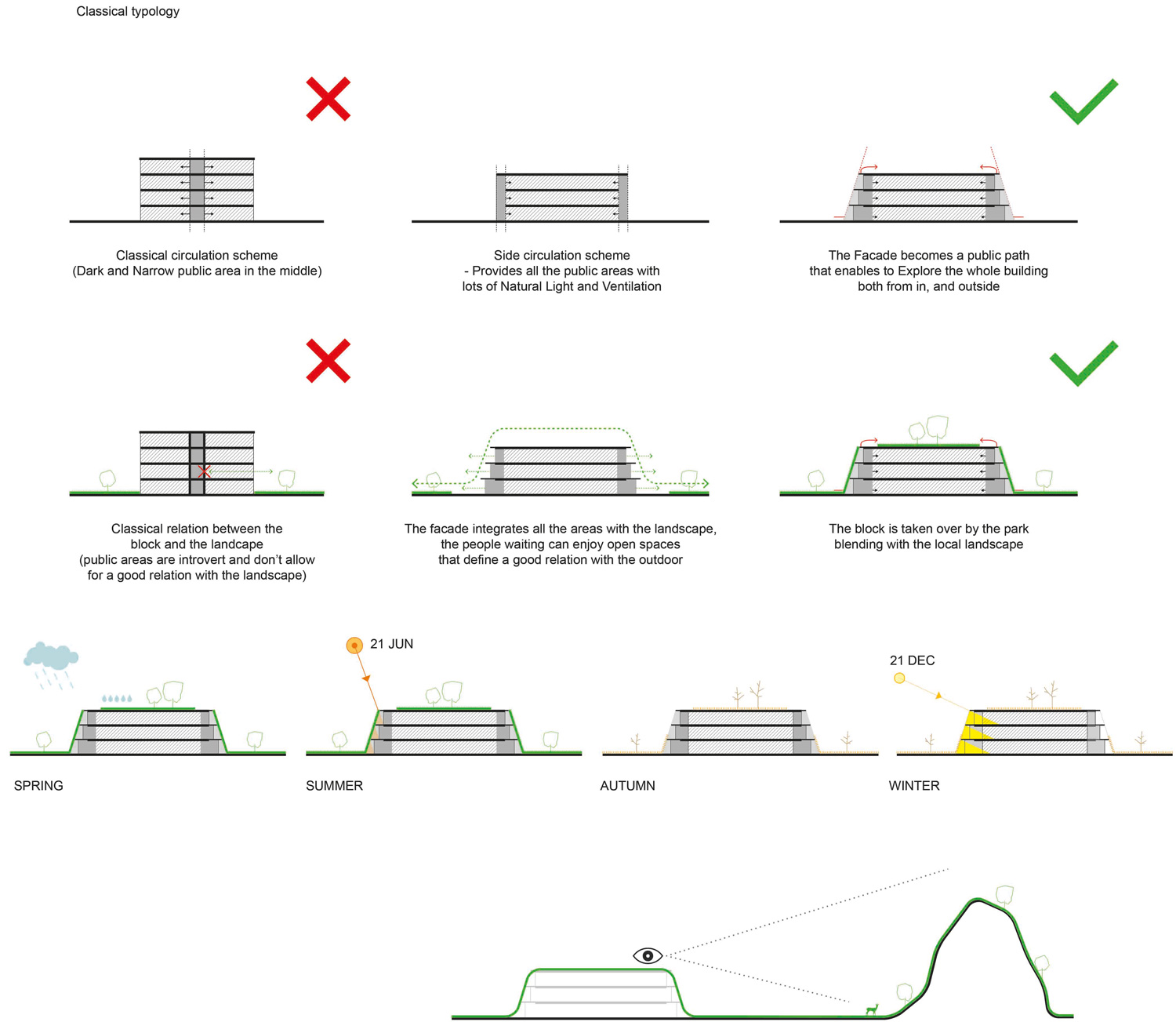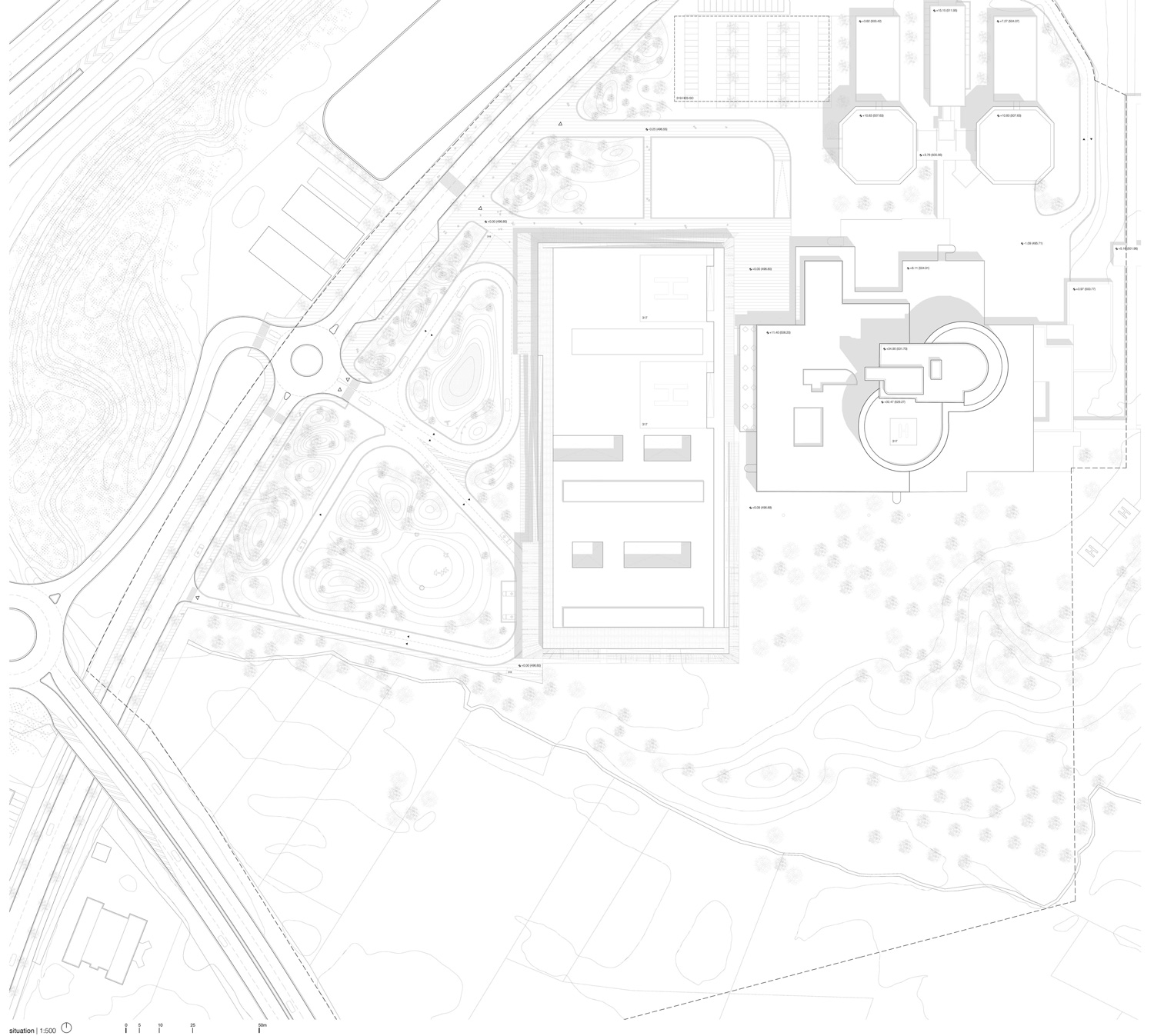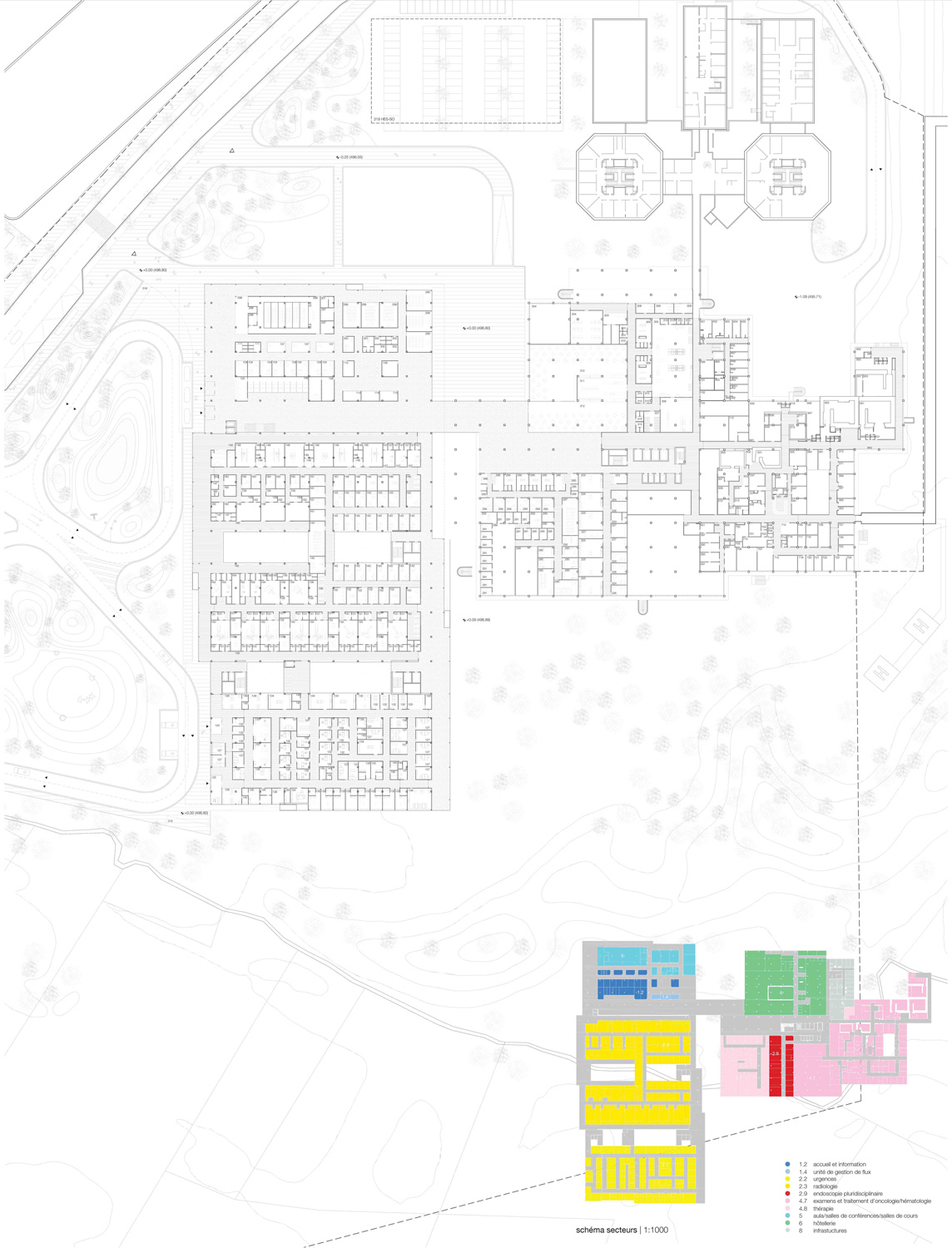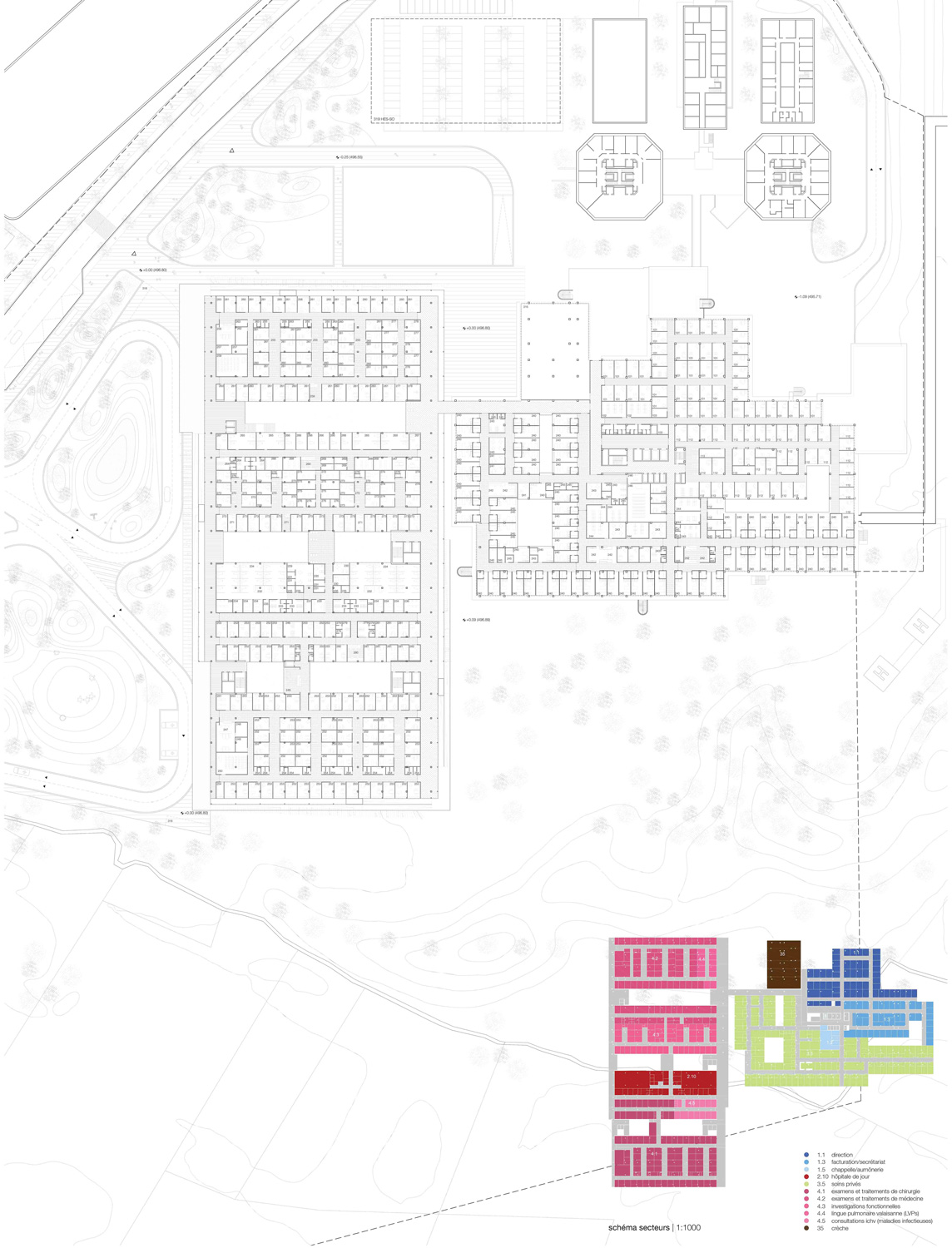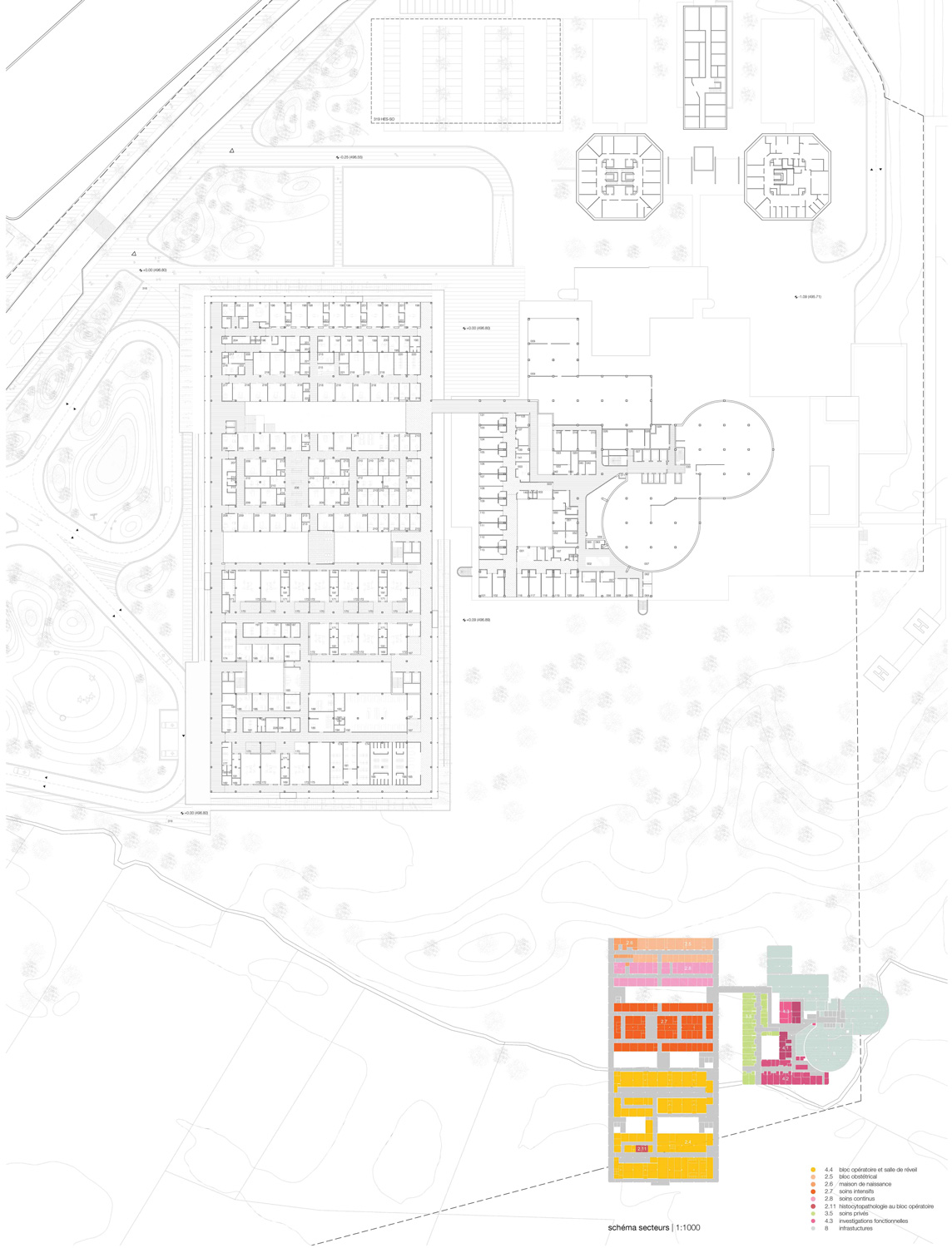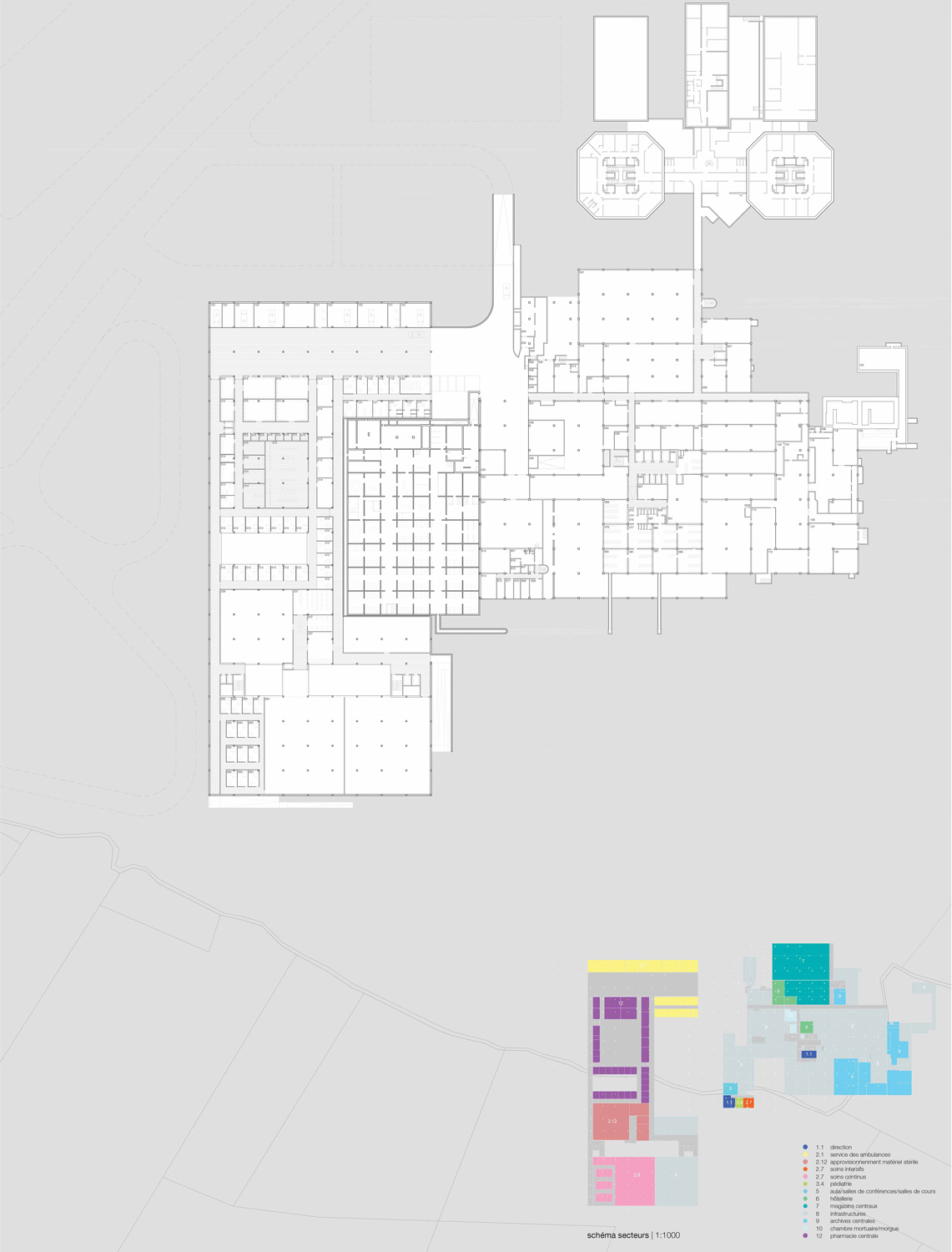1357-AZP-CH-2015
Client: Hospital of Valais
Status: Competition (2015)
Location: Sion, Switzerland
Coordinates: 46.235181, 7.386779
Climate: Oceanic / maritime, Temperate
Materials: Concrete, Glass, Vegetal
Environment: Urban
Visualizer: SBDA
Budget: 205.000.000 €
Scale: 48.176 ㎡ Large
Ratio: 4.255,23 €/㎡
Types: Healthcare, Hospital
Inspired by the beauty of the surrounding landscape as well as the strong seasonal variations of the local climate, our proposal for the Valais Hospital in Sion has been designed to reconcile these preexisting natural qualities of the site with the scale of programmatic required for the new extension of the Hospital.
Given the large scale required in hospital buildings, these structures are often built in opposition to their natural surroundings. Paradoxically, these infrastructures created to heal human nature are often some of the largest disturbances with the natural landscape. Our proposal instead seeks to establish a dialogue between the new building and the surrounding natural environment by enacting strategies to diminish the conflict between the artificial environments required to maintain necessary antiseptic conditions to accommodate the hospital performances and the natural context which customarily surrounds these types of infrastructures. Establishing dialogues between the new hospital building and its surrounding landscape will be advantageous not only to preserve the surrounding natural ecosystems, but also for the well-being of the patients of the hospital.
Locational strategy
From the area designated for the extension of the hospital, we have decided to locate the new hospital building to the West of the existing hospital facilities. We consider that the natural landscape present on the Southern edge of the site is worth preserving. While the green canopy, dunes and the creek which exist now on the Southern edge of the site are to some degree manmade, they have generated a natural environment which has certainly some beauty and integrity, and could potentially become an asset to the complex. On the other hand, the parking lot that is currently occupying the area between the existing hospital and the road limiting the site to the west is going to be relocated to a new parking building in the Northwestern corner of the site.
As this area has already been disturbed with an asphalt platform which will be made redundant, we believe that this is an ideal area to locate the new hospital building, without adding further stress to the local ecologies. The proximity to the access road to this Western region is also another advantage of this location that optimizes vehicular circulation access from the elevated highway. The internal circulation between the existing facilities and the new extension will be ideal, given the proximity with the existing hospital circulation structure. Furthermore, this location will grant the new building with a new public façade that will be recognizable to visitors approaching the complex, providing the hospital with an updated identity.
By locating the new building to the west of the existing hospital, all exterior and interior circulations can be resolved efficiently: the general and the emergency drop-off areas can be connected directly to the access roundabout, providing the shortest connection to the access route. While both drop-offs share the main façade of the new building, they have been located on the Northwest and Southwest corner respectively, to avoid traffic conflict between emergency access and regular visitors. Beyond the bus station situated north of the site, a new bus stop is proposed in front of the public drop-off area of the new extension to grant an easy access for visitors and personnel using public transport. The pedestrians approaching from the bus stop and the parking building will access the new facilities through the Northwest corner, where the general drop-off area has been located.
Massing strategy
The general massing of the hospital has been resolved within a paralellepipedic volume with a rectangular footprint 150,50 x68m oriented in the North-South direction. The footprint is extruded 3 storeys above ground and 1 story below ground (basement level) which will provide 4 levels of facilities. The medical functions have been located in the center of this volume while the vertical cores and public circulation areas have been planned in the perimeter of the building to maximize the interaction between the visitors and public areas and the surrounding landscape. In order to lit the hospital facilities, the paralellepipedic volume has been pierce by 3 linear of courtyards 10m wide East to West oriented, which leave 30m wide floor plates, ideal for hospital environment. These courtyards will provide daylight and fresh air to the different levels of the hospital and will host trees and vegetation to incorporate nature within the usually artificial hospital environment.
Circulation system
Conforming a ring-like circulation diagram on the perimeter of the block, the vertical cores and circulation routes split into two sides: the internal logistic hospital circulations have been concentrated in the Eastern façade to connect effectively to the existing circulatory system. The Eastern corridor system is adjacent to the existing hospital building being able to connect the existing and new building facilities. The North, South, and Western facades, have been designated for public circulation. This peripheral circulation ring will act as an interface between the interior environment and the exterior landscape. In the public area, this interface zone will host the public waiting areas, vertical cores and circulation corridors in a location which makes them permeable to the surrounding natural landscape. The envelope of the building is provided with a system of platforms and connection ramps that invite the hospital users to reach out to the terraces, and enjoy the landscape while they are waiting for their appointments.
The ramps and platforms that project out from the waiting and circulation areas connect the different levels enabling the movement of visitors from the landscape level to the roof platform. The building will be experienced by the users as a topographical volume from where to enjoy the surrounding landscape.
A Green Envelope
The ramps and circulation areas will be wrapped by a net-like green envelope composed by a sequence of cables and meshes where creepers will grow from the garden level and the green roof. The cables serve two purposes: they hold the vegetation to generate a microclimate in the outdoor terraces and circulation areas as well as in the interior waiting and public rooms. During summer, the vegetation will be most abundant, generating a green layer to filter the access of direct sunlight. During autumn, trees and vegetation will acquire a reddish color, changing the quality of light in the interior spaces while blending the building with the seasonal variations of the exterior landscape. In winter, foliage will decrease, enabling a direct access of natural light to the interior spaces. In spring time, the vegetation will grow back with bright colors and flowers, animating the interior and exterior spaces. The cables in some zones will also serve structural purposes. The drop-off canopies and the connection passage between the existing and new building, as well as the projecting ramps will be structurally reinforced by the cables themselves.
Programmatic Distribution
The East-West courtyards divide the floor plans in 4 main areas, each occupying 2.025 m2 on the ground floor, and adjacent to the hospital day entrance and main drop-off in the Northwest corner, the reception and meeting areas have been located. The first row of courtyards that follow the reception area, have been closed to form a reception lobby that is connected with the main vertical core, cafeteria, dining area and rehabilitation zone located in the existing building. On the west corner of the existing building and adjacent to the main vertical circulation core and rehabilitation zone, the oncology area is located.
The lobby is followed to the South by two units of radiotherapy, and in the last unit adjacent to the Southern limit of the site, we have located the emergency area. The emergency access and drop-off area have been located on the Southwest corner to avoid vehicular flow conflicts with the general hospital access drop-off. On the first floor of the new building, the units of outside consultation have been allocated. This floor also connects with the existing building through a bridge located in the Eastern internal corridor area. Adjacent to the new building Eastern façade, in the existing building, the accounting and hospital office spaces have been located, while on the Western side, the hospitalization rooms have been organized.
Finally on the second floor of the new building, the operating and recovery rooms have been located. This level is also connected with the existing building through a bridge that spans from the Eastern façade internal circulation area. These bridges that connect the new and existing building are located in axis with the core of the existing building to minimize the travelling distances. On the second floor of the existing building, the hospital rooms are planned.
On the Northern area of the basement level, additional loading bays are proposed. A logistic area is proposed followed by the pharmacy and the storage rooms. In the western corner, the psychiatry unit is proposed. The courtyard brings natural light to the basement area where the psychiatry has been located. Also this area will enjoy its own access which will also take place from the main façade through a ramp. The basement floor area is smaller than the remaining floors given that the building overlaps the refuggio which occupies part of the basement area.
Structural considerations
This volume has been resolved with an efficient 7.5m x 7.5m concrete structural grid with concrete flat slabs, hich will provide maximum flexibility to the infrastructure providing the future resilience that the structure will require.
Given the overlap between the underground shelter and the existing building, structural studies have been developed to guarantee that the proposed structural rhythm doesn’t conflict with the structure of the refuggio. The exits of the underground shelter and the ventilation shafts have also been redesigned to adjust to the new boundaries.
The structure of the new building is a reinforced concrete structure. The vertical loads will be transmitted by flat slabs on a regular frame of poles of 7.50 x 7.5 m. Several centers form the bracing of the structure. They will contain the vertical circulation and service shafts powering the entire building. The regular arrangement of cores allows for a supporting structure, without large eccentricities, which is adapted to seismic stresses.
The building is based on a reinforced slab in areas carrying heavy loads. The level of the groundwater (490m) is below the foundation level (491,97m). No specific provision is therefore necessary to protect the building against water.
Ramps flanking the main structure of the building will have a gantry shape, so that intermediate post is not necessary. The vertical loads are transmitted to the frame of the external poles and the primary structure. In the horizontal direction, the ramps will be fixed to the primary structure of the building. Balconies with the biggest cantilever will be suspended by cables to the building ceiling.
The new building will be located at a distance of 4.5 m from the existing building.
To address the risk of falling of the existing structural elements in an earthquake, the new building of the ceiling will be sized so that it can carry this load without damage. The ramps flanking the new building only serve the additional access and are not in the event of a seismic disaster. The new building will be located above the protected operating center (POC). The vertical loads of the new structure are transferred by a supporting grid at the basement of the slab to the supporting frame of the existing structure. The bracing of the new structure is out of the POC area, so the impacts to the existing structure are minimized.
